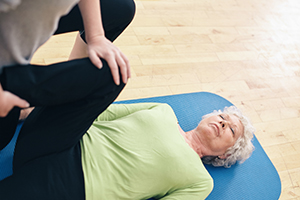Health Blog: Solutions & Wellness Tips
Spreading therapy over time may be more beneficial than consecutively

Strategies are needed to help patients maintain positive effects of therapy
Osteoarthritis (OA) is a common disorder in which protective cartilage surrounding joints gradually wears away. The condition is most prevalent in adults over 65 years old, and most commonly affects the knee and hip. Manual therapy is a treatment in which a physical therapist performs manipulations and mobilizations with their hands, and it is commonly combined with exercise therapy to treat knee OA. Unfortunately, it's not clear if using manual therapy adds any benefits to those from exercise, and strategies are needed to help ensure patients maintain the benefits of therapy in the long-term. One suggestion is to include "booster sessions," in which patients receive physical therapy every few months after their initial sessions to increase its effectiveness. More research is needed on booster sessions, so a powerful study called a randomized-controlled trial (RCT) was conducted to compare the effects of manual therapy, booster sessions, and exercise therapy for patients with knee OA.
Participants randomly assigned to one of four groups
Patients with knee OA that were 40 or older were evaluated for inclusion, and 66 fit the criteria and were randomly assigned to one of four groups. The exercise therapy without booster sessions (group 1) followed a treatment program led by a physical therapist of aerobic, stretching and strengthening exercises, as well as some individualized exercises, during 12 45-minute sessions over nine weeks. Group 2 was exercise therapy with booster sessions. They received the same treatment as group 1, but only had eight sessions over the first nine weeks, followed by two booster sessions at five months, and then one session at eight and 11 months. Group 3 was exercise therapy plus manual therapy with no booster sessions, and they received the same treatment as group 1, plus manual therapy. This took place during 12 30-45-minute sessions on top of exercise therapy, and focused on increasing the flexibility of the knee. Finally, group 4 was exercise therapy plus manual therapy with booster sessions, and followed the same schedule as group 2. All patients were assessed before the study and one year later using a test for pain, stiffness, and function.
Manual therapy or booster sessions may add benefit, but not in combination
Results showed that adding either manual therapy or booster sessions to exercise therapy led to greater benefits in pain and disability compared to exercise therapy alone, but when both were combined, the same outcomes were not found. It's possible that utilizing both manual therapy and booster sessions may actually take away from the overall effect of the treatments, and more research is needed to investigate this. Nonetheless, it appears that adding manual therapy or booster sessions to an exercise therapy program for knee OA may lead to greater improvements for patients in the long-term. Both of these approaches should therefore be considered independently.
-As reported in the September'15 issue of JOSPT
July 1, 2016
Back to Health BlogRECENT POSTS
- What You Need to Know About Alcohol and Heart Health
- Exercise Therapy Provides Strong Evidence of Its Effectiveness
- Strength in Age: The Power of Resistance Training for Older Adults
- Hip Strength and Groin Pain: What Athletes Need to Know
- Shoulder Pain Slowing You Down? A Physical Therapist Can Help
- Ending the Myths of Hip Pain and Finding Help From Physical Therapy
- Move More, Age Better: How Exercise Can Slow Down the Aging Process
- Why Pain Doesn’t Always Mean Injury – And What You Can Do About It
- Avoid Surgery and Talk to a Physical Therapist About Foot Problems
- A Personalized Physical Therapy Program Can Assist with Whiplash
